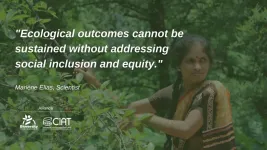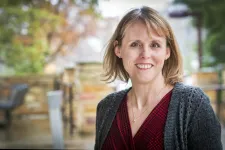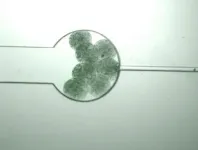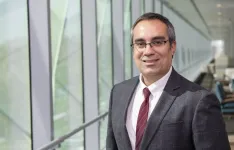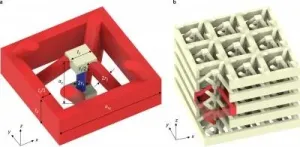INFORMATION:
The special issue on 'Restoration for whom, by whom: Exploring the socio-political dimensions of restoration' is a collaborative initiative conducted under the umbrella of the CGIAR Research Programs on Forests, Trees and Agroforestry; Policies, Institutions, and Markets; and Water, Land and Ecosystems.
As a decade of ecosystem restoration kicks off, don't forget the people
Global ecosystem restoration efforts are often measured by billions of trees planted or square kilometers of land restored. But there is a critical void in the agenda: The social and political dimensions that make restoration a success
2021-06-10
(Press-News.org) With the start of the United Nations' Decade on Ecosystem Restoration, which runs through 2030, a tremendous amount of money and effort will be put into re-growing forests, making over-exploited farmland productive, and reviving damaged marine environments. This is a good, and vital, initiative. Without quick action to clean up the fallout of humanity's scorched-earth economic systems, goals on hunger, biodiversity and climate will be unattainable.
But in examining restoration projects already underway across the globe, a group of scientists has found that restoration action is at risk of failure if it doesn't make social and political considerations at the center of efforts.
"Biophysical considerations are usually central to restoration efforts," said Marlène Elias, a CGIAR gender researcher at the Alliance of Bioversity International and CIAT. "While there's usually a peripheral nod at other issues, there generally isn't substantial engagement with the social, human and political dimensions of restoration."
The research is part of a special edition of Ecological Restoration titled "Restoration by Whom, for Whom," published in June 2021. The eleven papers include a successful kelp restoration project on Canada's West Coast, centered on the worldviews, ethics, and values of the Haida First Nation, with co-authors from the Haida First Nation. There is a study of a lake restoration project in Bangalore, India, where the lake ecosystem was "successfully" restored but the main beneficiaries were well-heeled urban residents at the exclusion of more vulnerable local communities who used to depend on the lake to fish, water their livestock, and more. Another group of authors reflect on inclusiveness in restoration based on their experience developing a mangrove restoration project with local communities.
Other research included work onfarmer-managed natural regeneration in Ghana, on-farm experiments and payments for ecosystem services in Kenya, a government-led tree planting initiative in Vietnam and the use of an adapted Restoration Opportunities Assessment Methodology in India. The remaining papers provide perspectives on multi-stakeholder engagement and restoration approaches that offer entry points for inclusive restoration.
Authors include scientists from the CGIAR's International Food Policy Research Institute, International Water Management Institute, and World Agroforestry, as well as from universities, Indigenous communities, NGOs, governments, the World Resources Institute, and other organizations from around the globe.
"Restoration projects need to be more inclusive," Elias said. "If you're looking at major goals like restoring millions of square kilometers of land, planting a trillion trees, or rehabilitating marine ecosystems, you're almost certainly not going to have success unless you put people at the center of the work."
A feminist political ecology of restoration
In the collection's introductory paper, Elias and the special issue's co-guest editors, Deepa Joshi and Ruth Meinzen-Dick, delve into "feminist political ecology" (FPE) and what this means in the context of ecological restoration. Meinzen-Dick said that one reason that social and political issues are often left out of restoration projects is because they're "messy." Top-down, one-size-fits all "solutions" tend to fail because land-rights issues, complicated relations among stakeholders, divergent worldviews and value systems, and potentially unequal distributions of benefits and costs are not addressed at the outset. While many oft-disenfranchised groups are left out of restoration plans, rural women face some of the most significant constraints in top-down restoration projects.
"Our aim is to prompt critical reflection that can open new avenues for meaningful engagement with issues of power and justice in restoration, to challenge the assumptions and discourses that (re)produce the status quo, and suggest ways forward for more political, inclusive agendas," Joshi writes.
The FPE approach focuses on three main pillars: gendered power relations, historical awareness and scale integration. The first refers to the inter-relations and inequalities on the basis of gender and other factors of social differentiation that shape rights to resources, decision-making, labor, and more that critically influence natural resource management.
Historical awareness means recognizing that current patterns of resource use and management can't be understood within considering the historical social, economic, political, and ecological contexts within which they are embedded. Scale integration refers to the fact that local resource management strategies are a function of factors (such as institutions) that go far beyond the local scale, such as international agendas, national policies, markets and commodity prices.
"We conclude that much needs to change to address the systemic fault lines that create exclusions in restoration policies and practice, and to legitimize the plural voices, values, meanings and situated knowledges of what makes the environment or nature in order to sustainably transform degraded landscapes," they write.
None of this undermines the importance of applied ecological science in restoration initiatives: the understanding of ecosystem function, interactions between diverse species ranging from fungi to trees, and the importance of biodiversity in restoration are all key to successful restoration.
"But the dominance of the natural sciences over the social sciences in the field of restoration results in a framing of restoration as a primarily technical issue, rather than as a socio-ecological issue with multiple, intricately intertwined dimensions," Elias said. "Ecological outcomes cannot be sustained without addressing social inclusion and equity. The point of restoration is not only to enhance ecosystem services, but to ensure the ecological, social, economic, cultural, and other functions that landscapes under restoration provide to improve human wellbeing."
ELSE PRESS RELEASES FROM THIS DATE:
Dinosaurs lived in greenhouse climate with hot summers
2021-06-10
Palaeoclimatologists study climate of the geological past. Using an innovative technique, new research by an international research team led by Niels de Winter (VUB-AMGC & Utrecht University) shows for the first time that dinosaurs had to deal with greater seasonal differences than previously thought.
De Winter: "We used to think that when the climate warmed like it did in the Cretaceous period, the time of the dinosaurs, the difference between the seasons would decrease, much like the present-day tropics experience less temperature difference between ...
Institutional environments trap disabled geoscientists between a rock and a workplace
2021-06-10
Inaccessible workplaces, normative departmental cultures and 'ableist' academic systems have all contributed to the continued underrepresentation and exclusion of disabled researchers in the Geosciences, according to an article published today (Thursday 8 June) in Nature Geosciences.
The article argues that changes to both working spaces and attitudes are urgently needed if institutions are to attract, safeguard and retain people with disabilities.
Anya Lawrence, a disabled early career researcher in the University of Birmingham's School of Geography, Earth and Environmental Science and author of the piece says:
"Disabled geoscientists like myself face barrier after barrier on a daily ...
Depression in old age: Smoking and other risk factors less decisive
2021-06-10
People who smoke, suffer from high blood pressure, obesity, or diabetes are not only at greater risk of suffering a stroke, heart attack, or dementia. For them, the risk of being affected by depressive mood or depression also increases. The more risk factors a person has, the more likely this is. Until now, however, it was unclear whether this probability also depends on their age. Earlier studies had already shown for other diseases such as dementia or stroke that a combination of several risk factors leads to a more frequent onset of the disease between the ages of 40 and 65 than in old age. Until now, however, it was unclear whether this also applies to depression.
Researchers ...
Three factors may predict college students' loss of self-control, WVU study finds
2021-06-10
MORGANTOWN, W. Va.-- Joining a club that sparks a new interest, playing a new intramural sport or finding a new group of friends may be just as indicative of a college freshman's loss of self-control as drinking or drug use, according to new research at West Virginia University.
Self-control--the ability to exercise personal restraint, inhibit impulsivity and make purposeful decisions--in that first year partly depends on a student's willingness to try new things, including things adults would call "good."
That's a new finding, according to Kristin Moilanen, associate professor of child development and family studies. The study, "Predictors of initial status and change in self-control during the college transition," observed 569 first year ...
Cells construct living composite polymers for biomedical applications
2021-06-10
DURHAM, N.C. - Biomedical engineers at Duke University have demonstrated that a class of interwoven composite materials called semi-interpenetrating polymer networks (sIPNs) can be produced by living cells. The approach could make these versatile materials more biologically compatible for biomedical applications such as time-delayed drug delivery systems.
The research appears online on June 8 in the journal Nature Communications.
The concept of sIPNs has been around for more than 100 years and has been used in automotive parts, medical devices, molding compounds and engineering plastics. The general idea is for one or more polymers to assemble around another polymer scaffold in such a way that they become interlocked. Even though ...
Humans are ready to take advantage of benevolent AI
2021-06-10
Humans expect that AI is Benevolent and trustworthy. A new study reveals that at the same time humans are unwilling to cooperate and compromise with machines. They even exploit them.
Picture yourself driving on a narrow road in the near future when suddenly another car emerges from a bend ahead. It is a self-driving car with no passengers inside. Will you push forth and assert your right of way, or give way to let it pass? At present, most of us behave kindly in such situations involving oth-er humans. Will we show that same kindness towards autonomous vehicles?
Using methods ...
Investing in an HEPA air purifier might not be a bad idea
2021-06-10
As COVID-19 restrictions ease nationwide and more people host indoor gatherings, investing in a high efficiency particulate air (HEPA) purifier might not be a bad idea, says a University of Cincinnati College of Medicine researcher.
Several published studies evaluating aerosols and submicron particles similar in size to the SARS-CoV-2 virion have shown that portable HEPA purifiers are able to significantly reduce airborne COVID-19 particles, says Ahmad Sedaghat, MD, PhD, director of the UC Division of Rhinology, Allergy and Anterior Skull Base Surgery.
Sedaghat identified the medical literature showing published studies on the effectiveness ...
Novel materials: Sound waves traveling backwards
2021-06-10
Acoustic waves in gases, liquids, and solids usually travel at an almost constant speed of sound. So-called rotons are an exception: their speed of sound changes significantly with the wavelength, and it is also possible that the waves travel backwards. Researchers at Karlsruhe Institute of Technology (KIT) are studying the possibilities of using rotons in artificial materials. These computer-designed metamaterials, produced by ultra-precise 3D laser printing, might be used in the future to manipulate or direct sound in ways that have never been possible before. A report on the researchers' work has been published in Nature Communications. (DOI: 10.1038/s41467-021-23574-2)
Rotons are quasiparticles, which means that they behave ...
LSU Health New Orleans study reports compound blocks SARS-CoV-2 and protects lung cells
2021-06-10
New Orleans, LA - Research conducted at LSU Health New Orleans Neuroscience Center of Excellence reports that Elovanoids, bioactive chemical messengers made from omega-3 very-long-chain polyunsaturated fatty acids discovered by the Bazan lab in 2017, may block the virus that causes COVID-19 from entering cells and protect the air cells (alveoli) of the lung. Their findings are published online in Scientific Reports, available here.
"Because the compounds are protective against damage in the brain and retina of the eye and the COVID-19 virus clearly damages the lung, ...
Economic crime is going uninvestgated as Police hide behind the veil of Action Fraud
2021-06-10
Fraud is going uninvestigated by police who are "hiding behind the veil" of the Action Fraud national crime reporting agency.
In his paper published this week in Policing, Professor Mark Button, director of the Centre for Counter Fraud Studies at the University of Portsmouth argues that, Action Fraud, which has been widely derided, has become a useful veil from which the police can hide their inadequate response.
Figures from Action Fraud, the arm of the police responsible for recording scams and fraud, show that between 2019 and 2020, over 800,000 people reported being a victim of fraud, with £2.3bn finding its way into criminal hands. However, Professor Button calculated just 0.6 per cent of police officers ...
LAST 30 PRESS RELEASES:
Tracing the quick synthesis of an industrially important catalyst
New software sheds light on cancer’s hidden genetic networks
UT Health San Antonio awarded $3 million in CPRIT grants to bolster cancer research and prevention efforts in South Texas
Third symposium spotlights global challenge of new contaminants in China’s fight against pollution
From straw to soil harmony: International team reveals how biochar supercharges carbon-smart farming
Myeloma: How AI is redrawing the map of cancer care
Manhattan E. Charurat, Ph.D., MHS invested as the Homer and Martha Gudelsky Distinguished Professor in Medicine at the University of Maryland School of Medicine
Insilico Medicine’s Pharma.AI Q4 Winter Launch Recap: Revolutionizing drug discovery with cutting-edge AI innovations, accelerating the path to pharmaceutical superintelligence
Nanoplastics have diet-dependent impacts on digestive system health
Brain neuron death occurs throughout life and increases with age, a natural human protein drug may halt neuron death in Alzheimer’s disease
SPIE and CLP announce the recipients of the 2025 Advanced Photonics Young Innovator Award
Lessons from the Caldor Fire’s Christmas Valley ‘Miracle’
Ant societies rose by trading individual protection for collective power
Research reveals how ancient viral DNA shapes early embryonic development
A molecular gatekeeper that controls protein synthesis
New ‘cloaking device’ concept to shield sensitive tech from magnetic fields
Researchers show impact of mountain building and climate change on alpine biodiversity
Study models the transition from Neanderthals to modern humans in Europe
University of Phoenix College of Doctoral Studies releases white paper on AI-driven skilling to reduce burnout and restore worker autonomy
AIs fail at the game of visual “telephone”
The levers for a sustainable food system
Potential changes in US homelessness by ending federal support for housing first programs
Vulnerability of large language models to prompt injection when providing medical advice
Researchers develop new system for high-energy-density, long-life, multi-electron transfer bromine-based flow batteries
Ending federal support for housing first programs could increase U.S. homelessness by 5% in one year, new JAMA study finds
New research uncovers molecular ‘safety switch’ shielding cancers from immune attack
Bacteria resisting viral infection can still sink carbon to ocean floor
Younger biological age may increase depression risk in older women during COVID-19
Bharat Innovates 2026 National Basecamp Showcases India’s Most Promising Deep-Tech Ventures
Here’s what determines whether your income level rises or falls
[Press-News.org] As a decade of ecosystem restoration kicks off, don't forget the peopleGlobal ecosystem restoration efforts are often measured by billions of trees planted or square kilometers of land restored. But there is a critical void in the agenda: The social and political dimensions that make restoration a success
